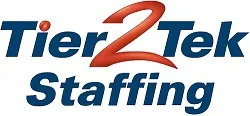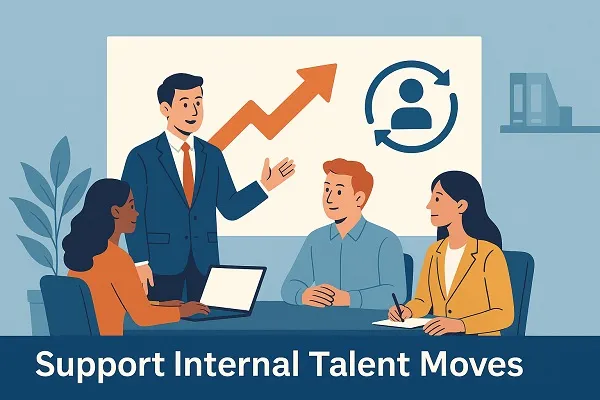Supporting internal talent moves is one of the most impactful actions hiring managers can take to strengthen teams, retain high performers, and enhance organizational success. Internal mobility doesn’t just fill positions—it helps employees grow while optimizing company-wide capabilities. For hiring managers, actively supporting internal talent moves creates loyalty, reduces hiring costs, and accelerates performance.
Why Hiring Managers Should Prioritize Internal Talent Moves
Supporting employees who want to explore new opportunities within the company benefits everyone. When internal mobility is encouraged:
- Retention increases: Employees who see growth options internally are less likely to seek external roles.
- Costs go down: Recruiting and training external hires is more expensive than promoting or transferring internal candidates.
- Onboarding is faster: Internal candidates already understand company processes, culture, and systems.
- Engagement rises: Employees feel valued and motivated when managers support their career goals.
By focusing on internal opportunities, hiring managers help foster a culture of development and trust.
Identifying Internal Candidates for Open Roles
Spotting strong internal candidates requires more than scanning resumes. Hiring managers must stay connected with their teams and the broader organization to recognize potential early.
Ways to identify internal talent:
- Partner with HR to access talent databases or skill inventories.
- Track employees who consistently deliver results and show initiative.
- Pay attention to those who excel in cross-functional collaborations.
- Listen during performance reviews when employees express growth ambitions.
- Look beyond job titles and focus on transferable skills that align with open roles.
This proactive approach ensures managers are prepared with a pool of talent when new opportunities arise.
Building a Culture That Encourages Internal Mobility
For internal mobility to work, employees must feel safe exploring opportunities within the company. Managers influence this by creating an environment of trust.
- Promote transparency: Communicate that internal mobility is encouraged.
- Celebrate mobility stories: Highlight employees who successfully transitioned internally.
- Avoid stigma: Ensure that employees don’t feel disloyal for pursuing internal moves.
- Recognize managers who support mobility: Reward leaders who develop and promote internal talent.
When employees know career development is supported, they’re more likely to pursue roles internally rather than externally.
A Step-by-Step Framework for Supporting Internal Talent Moves

Hiring managers can follow a structured process to support internal candidates:
- Proactively identify potential candidates through HR data, performance reviews, and team observations.
- Discuss career goals openly during regular check-ins to understand aspirations.
- Share opportunities transparently rather than waiting for employees to discover them.
- Encourage applications and reassure employees that you support their decision.
- Assess fairly by using objective criteria, not personal biases.
- Provide feedback whether the candidate is successful or not.
- Facilitate a smooth transition by negotiating timelines and supporting knowledge transfer.
- Continue mentorship after the move to ensure long-term success.
This structured approach balances organizational needs with employee growth.
Balancing Team Needs with Internal Moves
Managers often fear losing key employees. While it’s natural to protect team stability, blocking mobility leads to disengagement and turnover.
Instead of resisting, hiring managers can:
- Plan succession: Develop backup talent pipelines to fill future gaps.
- Use transitions as growth opportunities for remaining team members.
- Collaborate on timelines to minimize disruption.
- Encourage knowledge transfer before employees transition out.
Supporting internal moves strengthens the team’s resilience and ensures no one person becomes a single point of failure.
Best Practices for Supporting Internal Candidates
Consistency and fairness are crucial when handling internal applications. Hiring managers can build trust by applying best practices:
- Champion visibility: Regularly share internal opportunities.
- Encourage candid conversations about growth and goals.
- Assess based on potential as well as experience.
- Give clear and constructive feedback to both successful and unsuccessful candidates.
- Ensure smooth transitions with handover plans and collaboration.
These practices help employees feel valued while setting them up for success in their new roles.
Supporting Growth Through Lateral Moves
Not every move is about promotion. Lateral moves allow employees to expand their skill set, explore different functions, and prepare for leadership roles in the future.
Hiring managers should:
- Highlight the long-term value of diverse experience.
- Encourage employees to see lateral moves as growth steps.
- Publicly recognize contributions in lateral roles to maintain motivation.
This mindset helps employees see career progression as multidimensional rather than only upward.
Interview Questions for Assessing Internal Candidates

When interviewing internal candidates, hiring managers should strike a balance between evaluating new role readiness and acknowledging existing organizational knowledge.
Sample questions include:
- “What motivated you to apply for this role?”
- “How do you see your current experience transferring into this new role?”
- “What challenges do you anticipate in making this transition?”
- “Can you give an example of when you adapted quickly to a new responsibility?”
- “What impact do you hope to make in this role within the first six months?”
These questions help assess readiness while showing respect for the candidate’s existing contributions.
Metrics Hiring Managers Should Track
To evaluate the effectiveness of internal mobility, managers should monitor key metrics:
- Internal fill rate: Percentage of roles filled by existing employees.
- Retention after internal moves: How long internal hires stay in their new roles.
- Employee engagement scores: Improvement in engagement following internal mobility initiatives.
- Time-to-fill: Speed at which roles are filled with internal vs. external candidates.
- Performance outcomes: Success rates of internal hires compared to external ones.
Tracking these metrics ensures mobility strategies deliver measurable results.
Common Mistakes to Avoid
Even well-intentioned managers can inadvertently block internal mobility. Some mistakes to avoid:
- Holding back employees to protect team performance.
- Failing to share opportunities broadly.
- Dismissing candidates without transparent feedback.
- Overvaluing external experience while undervaluing internal potential.
- Allowing bias to influence decisions.
Avoiding these pitfalls strengthens employee trust and organizational credibility.
Empowering Employees to Take Ownership
While hiring managers play a central role, employees should also be encouraged to drive their own careers. Managers can empower them by:
- Providing visibility into job postings and opportunities.
- Supporting training and mentorship opportunities.
- Encouraging proactive conversations about long-term career goals.
- Offering guidance on building transferable skills for future roles.
This balance ensures employees feel supported but also responsible for their growth.
Supporting internal talent moves is one of the most strategic ways hiring managers can build stronger teams and improve retention. By identifying internal candidates, creating a culture of mobility, applying best practices, and tracking success with clear metrics, managers strengthen not only their teams but the entire organization. Employees who feel supported in their growth remain engaged, motivated, and committed to the company’s long-term success.
Content reviewed and published by Tier2Tek Staffing Editorial Team .

